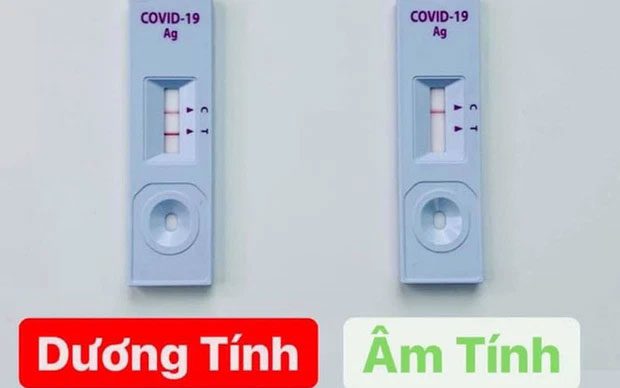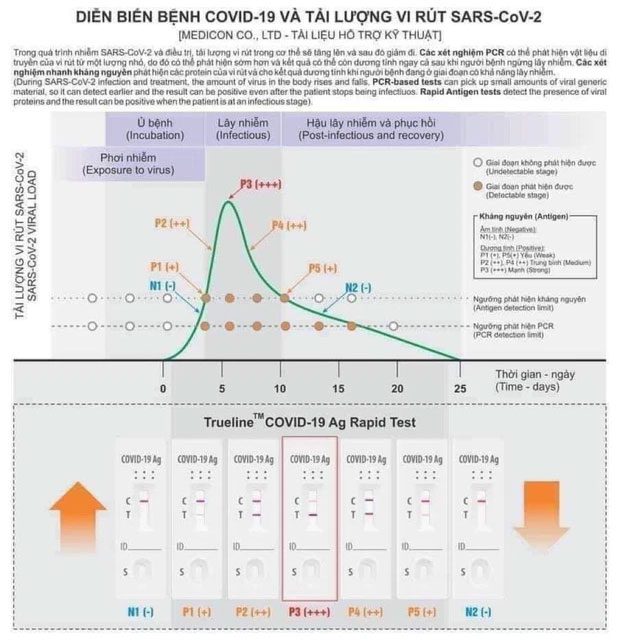Currently, the number of Covid-19 cases is rapidly increasing in most provinces and cities. People are rushing to buy rapid test kits and are continuously getting tested. Many are wondering whether a strong or faint T line indicates the severity of the illness.
Depending on the instructions of each rapid test kit, the reading time for results varies. Typically, the reading time is between 15 to 30 minutes. Results should not be read before or after the time specified in the product instructions.
- Negative Result: Only the control line C (red line) appears.
- Positive Result: Both the control line C and the test line T appear.
- The result is invalid if neither the control line C nor the test line T appears, or if only the test line T appears.
If the control line C does not appear, it may be due to insufficient sample or a faulty test tray, and the test should be repeated or contact health authorities for support.

Guide to reading rapid antigen test results.
Dr. Truong Huu Khanh, an advisor at the Neurology Infectious Diseases Department, Children’s Hospital 1 (Ho Chi Minh City) stated that a strong or faint T line does not provide prognostic value or indicate the severity of the illness.
According to Dr. Khanh, if the T line appears quickly and is darker than C, it indicates a higher viral load, and the patient should adhere to isolation to prevent transmission to others. If the T line appears faint, it indicates a lower viral load.
The expert advises that patients (F0) treating at home, whether asymptomatic or with mild symptoms, should remain calm and wait until the seventh day of illness to test again. If the T line is fainter than before or disappears completely, it indicates a low viral load.
By the fourteenth day, the patient should test again; if the T line is gone, they can safely “reintegrate into the community” provided they follow safety protocols.
In practice, to determine the viral load, patients must undergo RT-PCR testing. Colonel, Dr. Nguyen Huy Hoang from the High-Pressure Oxygen Center at the Vietnam-Russia Tropical Center, Ministry of Defense, stated that a high CT value corresponds to a low viral load. Conversely, if the CT value decreases, the viral load increases, but this does not necessarily mean the disease is worsening.
“The replication of the virus is a normal progression of the disease in most cases, usually decreasing after 5-7 days,” Dr. Hoang said.
To avoid wasting rapid test kits, Dr. Hoang guides home-treating patients (F0) on reasonable testing methods:
- If you have flu-like symptoms at this time, it is very likely you have contracted SARS-CoV-2. At this point, the patient should quickly self-isolate but should not test immediately as they may not yet show “two lines.” This is referred to as Day D.
- One day after showing flu-like symptoms (D+1), if you test positive with two lines, you have contracted SARS-CoV-2.
If you test positive with one line, do not celebrate yet; the next day (D+2) you should test again. If on Day (D+2) you test negative, wait an additional 2 days (D+4) and test again. If still negative, you can feel somewhat reassured.
- If you are positive on Day (D+1), estimate Day P5 as shown in the diagram, and do not test immediately. On Day (P5+1), if you test negative, congratulations, you are likely recovering.
If the T line remains faint, remain calm; test again in 2-3 days. If after retesting the T line is still faint, you can be assured that the risk of transmission to others is very low by that time.

Monitoring chart for Covid-19 progression and SARS-CoV-2 viral load. (Image: Medicon).
According to the Ministry of Health’s guidelines, if you have received the full vaccination doses and are not hospitalized, after 10 days (14 days if you have not received the full doses), regardless of whether there is still a faint line or not, the patient no longer needs to isolate.
“Thus, if you know how to save, each F0 only needs to use 2-3 rapid test kits. PCR is also no longer as necessary; regularly measuring SpO2 is more important.“, Dr. Hoang stated.
At the regular government press conference in February 2022, Deputy Minister of Health Do Xuan Tuyen advised the public to follow the Ministry of Health’s guidelines, only purchasing rapid tests when necessary, and not to rush to stock up, which disrupts the supply-demand balance. Buy only as needed.
The Ministry of Health also provides guidelines for pooled testing. In a family, pooled rapid tests can be conducted for 2 people. For example, with the Omicron variant, there is a 2-3 day infection cycle, so testing every 2-3 days will reduce the demand for tests.

















































